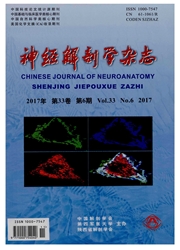

 中文摘要:
中文摘要:
本研究应用功能磁共振成像(functional magnetic resonance imaging,珊砌)技术,检测了健康人大脑和小脑参与空间记忆的认知过程。通过对lO名右利手健康志愿者进行一项短时空间记忆任务作业的同时进行脑功能磁共振扫描.实验采用组块设计,任务与对照任务交替进行,数据采用SPM99软件进行数据分析和脑功能区定位。结果显示:当统计阈值设定为P〈0.0001时,大脑皮层和右侧小脑一起被显著激活;大脑皮层所激活的脑区有双侧顶叶的楔前叶、顶上小叶、缘上回(BAT/40,BA:Brodma-nn Area),双侧前额上、中、下回(BA6/9/47),双侧枕叶和枕颞交界处(BA18/19/37),右侧海马回;左侧中脑黑质及被盖部也被激活。上述结果提示:小脑和大脑皮层一起参与了空间记忆的认知过程。
 英文摘要:
英文摘要:
Employing functional magnetic resonance imaging (fMRl) technique, we aimed to examine the involvement of the cerebral and corebellum in the spatial memory function of human brain. Ten right-handed normal volunteers participated in a test of short-term spatial memory task, while the fMRl data were recorded. A control task was performed for the block-design. SPM 99 was used to analyze the data and to get the activated brain regions. The results showed that when the threshold was set as P 〈0. 0001, both the corebral cortex and the right cerebellum were prominently activated. The cerebral cortex areas including the bilateral precaneus lobules and superior lobules as well as supramarginal gyms of the parietal lobe ( BA7/40), the bilateral superior, middle and inferior gyrus of the prefrontal lobes ( BA6/9/ 47), the bilateral oceipitotemporal lobes (BA18/19/37), the right parahippecampal gyms were activated during the task. The left substania nigra and the left tegmental division in the midbrain were also activated during the task. The above results suggest that the corebellure as well as the corebral cortex are collaborative to contribute to spatial memory function in human brain.
 同期刊论文项目
同期刊论文项目
 同项目期刊论文
同项目期刊论文
 期刊信息
期刊信息
